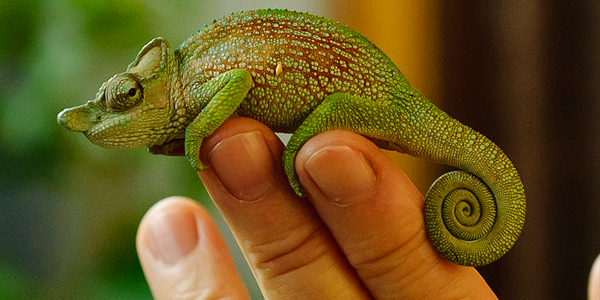It’s amazing how many of these false facts I actually believed that were taught to me through various friends, family or others. How many did you actually believe were true?
32. Bulls Are Enraged By The Colour Red
No, they’re actually not.
In fact cattle vision is dichromatic. This means that they’re essentially what would be described as ‘colour-blind’ in humans, so they don’t even see red as a bright colour. They merely perceive it as another variation in tone, like all the other variations.
The crew from TV’s MythBusters set out to debunk the myth a few years ago and managed to get exactly the same response from a bull when the matador held a red flag, a blue flag and a white flag. First the matador did nothing but hold the flags as motionless as possible – the bull gave a half-hearted attempt at charging each one before losing interest. But when the matador waved the flags, all three inspired the same reaction from the bull: irrespective of colour, when the flag was waved the bull charged at it.
So it turns out that next time you go to use the phrase “like a red flag to a bull” (or its alternative “like a red rag to a bull”) you could actually just call out any colour at all and your phrase will be just as valid. Why not make it a crimson flag, or a teal one, or even a chartreuse one?
31. Lightning Never Strikes The Same Place Twice
Actually, it can and it does, frequently.
There is no physical, meteorological, geographical or geological reason why lightning couldn’t strike in the same place twice. These days this one is typically used as a turn of phrase more than a statement of fact, but there’s still a sufficient volume of people who believe it.
Any time there’s an electrical storm, lightning looks for a conductor and the various metallic fixtures atop the tallest buildings in any given area are the obvious candidates. Lightning is said to strike conductors atop buildings and towers such as the Empire State Building in New York City, the Eiffel Tower in Paris, Toronto’s CN Tower, The Sydney Tower, and Auckland’s Sky Tower 50-100 times a year.
In fact weather-watchers and storm-chasers the world over will vouch for the fact that lightning frequently strikes twice in the same place. Some even argue that, whether there’s a gap of 2 minutes or 2 million years, it’s almost inevitable that the same spot will be struck by lightning twice, if not more often.
30. Vitamin C Is An Effective Treatment Against The Common Cold
No, actually it’s not.
While nobody’s arguing that Vitamin C is bad for you – it certainly is not – there’s been much research into the perceived benefits of Vitamin C in combating the good old common cold. To date, there’s been little, if any, evidence uncovered to support use of Vitamin C at the onset of a cold to reduce the length, severity or frequency of colds.
In 2007 researchers interrogated six decades worth of data from clinical research and concluded that Vitamin C, when taken at the onset of a cold, does nothing to reduce the duration or the severity of the cold. For adults who routinely ingested Vitamin C supplements on a daily basis, whether with or without a cold, Vitamin C was found to reduce the duration of colds in less than 10% of them. Across an entire year the benefit from routinely taking Vitamin C, if compared with an average adult who doesn’t do so, amounts to just one less day of suffering from colds.
While Vitamin C from natural sources is said to be essential, in seven separate studies Vitamin C supplements were found to be no more or less effective than a placebo in warding off the effects of a cold.
Next time someone tells you that you should be taking more Vitamin C, you now know exactly what to tell them.
29. You Can’t Fold A Piece Of Paper In Half More Than 7 Times
Actually, you can.
Given that there are far more types of paper in the world than just standard A4 copy paper, it seems absurd that anyone would’ve applied such a generalised statement to the topic, especially considering all the variations in paper thickness that exist as well as the fact that some paper – such as that used to print newspapers on – comes in enormous rolls of extraordinary length.
With a teeny tiny piece of paper you’d be hard-pressed to fold it more than a few times. You’re most likely to get 7 folds out of a piece of standard A4 copy paper, maybe 8 if you’re very strong. If you use a sheet of paper the size of a football field and have various mechanical and motorised aids such a steamrollers and cranes at your disposal, as the folk from TV’s MythBusters did in 2007, you can probably up the ante a little.
But a schoolgirl called Britney Gallivan had well and truly debunked the theory long before, back in 2002 while she was still in Junior High School, when she managed to get a sheet of paper foil to fold 12 times. She even went on to write a book about it, with the astoundingly thought-provoking title of “How to Fold Paper in Half Twelve Times – An “Impossible Challenge” solved and explained”.
Gallivan’s research is extremely technical and talks about everything from paper type, to fold techniques, from the strength of the folder to the equations associated with dynamics, mathematical limits and width ratios of folds. Riveting stuff, but at least it busted the myth.
28. Christopher Columbus Discovered America
No, actually he didn’t.
Over the course of four voyages, Christopher Columbus made landfall mostly on islands of the Caribbean. Its true that he was one of the earliest European explorers to chart part of the Americas – undoubtedly he was instrumental in starting a chain of events that lead to further European exploration and, ultimately, the colonisation of North America. But it’s also true that Columbus never once set foot on the North American continent.
In fact, the northernmost region of the Americas was first ‘discovered’ by its indigenous people, then by Viking seafarers during the 11th century. So even if Columbus had actually made physical contact with mainland North America with the intention of claiming he was the first European who’d ever been there, he still would’ve been three hundred years too late to the party.
Despite this, Americans joyously celebrate Columbus Day on the second Monday of every October, commemorating his first arrival in the Americas on 12 October 1492. Of the numerous states, cities and other districts choose not to observe Columbus Day, some have either a generic ‘indigenous persons’ holiday or a day celebrating local peoples in its place, while others choosing not to observe anything at all.
27. Eating Less Than An Hour Before Swimming Increases The Risk Of Muscle Cramps And Drowning
No, actually it doesn’t.
During our formative years, most of us would’ve been warned of the dire consequences of swimming within an hour of eating. We’ll get cramps, we were forewarned, and we’ll surely drown as a result. It was as if no alternative outcome was possible. If we went into the water without waiting a full sixty minutes from the moment we’d swallowed that last mouthful of the half a cheese sandwich we’d inhaled for lunch, we would die. It was a guaranteed death trap, a watery hangman’s noose, a vast ocean of peril dragging us beneath the waves to our certain death, with no chance of escape or survival…what kind of hideously awful children must we have been, if our parents had to tell us such terrifying horror stories just to make us behave?
There were at least a couple of schools of thought supporting the myth. The most common thinking seems to have been that the act of digestion took blood flow away from limbs and muscles used in swimming. The volume of blood diverted away from arms and legs during digestion was thought to be so significant that the inevitable result would be cramping which, in turn, would lead to drowning. Thing is, as much research over the years has shown, you’d virtually have to be swimming at an Olympic level immediately after consuming a three course meal for there to be any real chance of developing cramps in either the legs, the arms or the stomach, to say nothing of actually drowning. In fact, research has found that less than 1% of drowning victims die shortly after eating.
Of course it’s always warranted to be cautious where kids and water are concerned. But when Scouting For Boys set out this warning in 1908, it was perhaps a tad over the top: “First, there is the danger of cramp. If you bathe within an hour and a half after taking a meal, that is, before your food is digested, you are very likely to get cramp. Cramp doubles you up in extreme pain so that you cannot move your arms or legs — and down you go. You may drown — and it will be your own fault.”
26. Different Parts Of Your Tongue Detect Different Tastes
No, actually they don’t.
Well, yes they do, but in the context of the belief held by most people who use this statement, it’s actually not correct on two crucial points. Firstly, it suggests our tongues can only detect four tastes – sweet, sour, salty and bitter. Secondly, it claims the receptors for each of the taste senses are located at specific points on every tongue – sweet across the tip, then salty at left and right front, sour at left and right middle and, finally, bitter in the middle of the tongue towards the back. The reality is more chaotic but decidedly cleverer.
Our tongues contain up to 10,000 taste buds, each containing pores with taste receptors. Each receptor has a mechanism for detecting chemicals in our saliva, which tells us what something tastes like. These cells are exactly the same all over our tongues. Plus, the exact same receptors are also on the roof of our mouth, on the upper side of our oesophagus and on our epiglottis. Whenever saliva containing food chemicals makes contact with any of these receptors, on whatever surface inside our mouths, its flavour will be detected.
The myth is frequently propagated by pictures like the ones above. They’re based on the original “Tongue Map” which was, itself, the result of a badly translated 1901 German publication called The Psychophysics of Taste. Not only was the tongue map flawed from the get-go, it became even less relevant in 1908 when science established that umami – a savoury or meaty flavour – was, indeed, the fifth taste sense. The tongue map was finally rendered completely irrelevant in 1974, with the formal publication of scientific findings that all tastes existed all over the tongue.
25. Daddy Longlegs Are The Most Venomous Spiders To Humans (But Can’t Bite Us So Are Considered Harmless)
Nope, wrong on multiple levels… though not necessarily because the statement is incorrect or untrue.
Firstly, Daddy Longlegs do indeed have venom, but to know that they’re the most venomous spider suggests that someone, somewhere, at some time, reported having been bitten by one and that the results of the bite were examined and recorded. No such record exists anywhere in the world. There are also no records anywhere to indicate that toxicological tests on the effects of Daddy Longlegs Spider venom have never been undertaken on any kind of mammal whatsoever. As such, the toxicity of Daddy Longlegs venom to human beings can’t be quantified because it’s never actually been established. Therefore, the statement is not based in scientific fact.
Secondly, the numerous variations on the assertion that Daddy Longlegs Spiders can’t even bite humans have put it down to either the shape of their mandible, the short length of their fangs or simply that they’re such small things that they just don’t have the physical strength to pierce human skin. What’s known for sure is that other spiders in the same family, of a similar size and also with short fangs have indeed successfully pierced human skin. What isn’t known is whether or not a Daddy Longlegs Spider has ever done it successfully because, again, there are no examples of a bite from one ever having been recorded.
At most, it’s suspected that a bite from a Daddy Longlegs might see them injecting just enough venom to cause little more than a very briefly and very mild skin irritation. But, again, it’s supposition because if it’s ever happened, either nobody’s noticed, it’s never been reported to a medico or it’s never been formally recorded in writing.
So while it’s true to say that the oft-heard claims about Daddy Longlegs aren’t wrong per sé, neither do they have any basis in established fact.
24. You Will Get Arthritis From Cracking Your Knuckles
No you won’t!
Arthritis is an inflammation of the joints. There are at least seven diseases that specifically result in joint inflammation and associated discomfort, as well as up to twenty other conditions that can result in similar symptoms. “Cracking” of joints has never been found to be a contributor to any of them, nor to any other related or unrelated joint ailment.
The clincher with this old chestnut is that when you’re “cracking” your knuckles – or your back, your neck, your shoulder, elbows, feet or anything else you choose to crack – you’re not actually “cracking” anything. You are doing something a bit funky with your joints but, again, there’s no conclusive evidence to suggest that it contributes to any of the diseases or conditions commonly associated with Arthritis or joint pain.
The “cracking” sound that’s heard when we “crack” our knuckles is nothing more than redundant gasses being jettisoned from the fluid surrounding a joint. When pressure inside the joint chamber becomes too great and more room needs to be made for the joint to comfortably move, the chamber opens and gasses escape. What sounds and feels like a “crack” is really more of a “pop” – the high-powered hiss of the gas shooting out of the joint chamber.
So even if you hear a snap in among all that crackling and popping, cracking your knuckles won’t do anything to increase your chances of developing Arthritis.
23. Bats Are Blind
Actually, they’re not.
If you’ve ever accused someone of being “blind as a bat”, you were actually – and probably unwittingly – proffering quite the compliment, if only about their eyesight.
There are two distinctly different lines of bat, evolved from a common ancestor. While one has larger eyes and much more refined eyesight than the other, not a single one of the 1200 or so species of bat suffers with naturally occurring blindness and, in fact, many of them can actually see in the dark better than we humans can.
While some are more prone to degraded vision in a low light environment, they can also fall back on a snazzy sonar mechanism called ‘echolocation’. This allows the bat to sense distance by sending out high-frequency sounds which come back to it after bouncing off the nearest object. So bats are actually quite a bit cleverer than most of us give them credit for being.
And therein lies the curse of the sweeping generalisation based on unsubstantiated fact – sooner or later, someone will prove it wrong!
22. Slaves Built The Pyramids
No, actually they didn’t.
Not Jewish slaves. Not even Egyptian slaves. It was long thought to be inconceivable that anyone could’ve voluntarily become one of the thousands of men required to construct these enormous and complex ancient Egyptian structures. But in the early 1990s, it became apparent that they had been.
Enough archaeological evidence has been uncovered around The Great Pyramid alone to show that the men working on its construction – estimated to around 10,000 of them over a thirty year period – were allocated comfortable accommodations, were fed meat at least weekly, had good medical care, were most likely well remunerated for their work and were given honourable burials in stone tombs close to the base of the pyramid when they died. It seems likely the majority of them were recruited from poor farming communities on a roughly three-monthly rotational basis, with many coming to the pyramids when their farms had been flooded by seasonal rains.
The earliest known record of Jews in Egypt apparently date to some 2,000 years after The Great Pyramid had its topping out ceremony and even then, they were Persian soldiers who later went into combat shoulder-to-shoulder with the Pharaoh’s troops – so certainly not slaves.
21. Sushi Is Raw Fish
No it is not!
How often have you heard someone say, “Sushi? No thanks, I don’t do raw fish”? Well if you didn’t already know, you’re about to find out exactly how to respond to their objections.
For one thing, in traditional Japanese cuisine when raw fish, or raw meat, is served on its own it’s known as sashimi. Sashimi and sushi are not one and the same thing and the two terms aren’t interchangeable. Sushi simply refers to any dish served with vinegared rice. While many of these dishes feature raw fish or other raw meats, just as many of them don’t. Sashimi can be consumed with sushi and vice versa though equally, one can be consumed without the other, reiterating that sashimi and sushi are not the same thing.
The most commonly occurring sushi outside Japan are nori rolls – sushi rice and various other fillings rolled between sheets of edible seaweed (‘nori’). These include many varieties of roll created specifically for western tastes and which are rarely, if ever, seen in Japan. The most well-known of these is the California Roll, consisting of avocado, imitation crab stick, cucumber and fish roe, usually rolled in the traditional way but often made with rice on the outside and the seaweed roll on the inside.
It would actually be pretty easy to eat sushi every day and never have to touch raw fish at all. The health benefits of doing so, however, might be debatable.
20. Toilet Waste Is Routinely Jettisoned From Aircraft
No, actually it isn’t.
Most modern aircraft use a vacuum waste system, which sees all our in-flight contributions sucked into a holding tank underneath the plane. The entire contents of the tank are then sucked back out of the plane into a waste disposal truck once it reaches the tarmac at the end of the flight. The mechanism by which the contents are emptied can only be accessed from the outside of the plane by airport ground crew. There’s no way for any member of the on-board crew to jettison the contents of the tank from inside the aircraft, whether on the ground or in the air.
In the unlikely event of a malfunction, some of the holding tank’s contents might leak but it certainly wouldn’t be a routinely undertaken procedure, if for no other reason than safety. Aside from all the other questionable outcomes, at high altitudes jettisoned waste content would likely freeze as it left the confines of the tank. In turn, this could result in serious damage to the aircraft itself, or to any other aircraft in the relative vicinity.
Though there have been instances of people reporting aircraft waste landing on them, on their houses or in their yards but these are few and far between and, often, unsubstantiated.
19. Mount Everest Is The Tallest Mountain In The World
No, surprisingly enough it technically isn’t, though this could be a contentious point.
At 8,850m above sea level, Mount Everest actually has the highest altitude of any mountain on earth – altitude referring to height above sea level.
However, if a mountain’s base is below sea level, then its actual height – the distance between its base and its summit – usually includes a fairly significant portion lurking below the waves. With that in mind, the world’s tallest mountain is actually Mauna Kea in Hawaii. It’s altitude of 4,250m is less than half that of Mount Everest, but with 60% of the mountain actually below sea level, Mauna Kea measures 10,100m from base to summit.
With very little of Everest’s bulk below sea level, its base-to-summit measurement is actually about 1,600m less than Mauna Kea’s.
So, technically, while Mount Everest has the highest altitude of any mountain on earth, Mauna Kea is actually the tallest.
18. Fortune Cookies Are A Chinese Tradition
As odd as it might seem, they’re actually not.
Fortune cookies are an American creation, though exactly who came up with the idea and where they emanated from is an ongoing source of some contention for Californians.
One story has a Cantonese immigrant to Los Angeles inventing fortune cookies in 1918 as a means of taking pity on the poor and homeless he saw near his shop every day. He would insert a piece of paper containing an inspirational message – typically Bible scripture written for him by a minister – before sealing the cookies and handing them out to the less fortunate.
The second story has fortune cookies invented by a Japanese man in 1914. He was the designer of the Japanese Tea Garden in San Francisco’s Golden Gate Park who was fired from the job by a mayor said to be anti-Japanese. Later reinstated to the role by a different mayor, he created a cookie that included a “thank you” message inside, as a means of showing how grateful he was for the support shown him whilst out of work. He distributed the cookies at the Japanese Tea Garden and they were eventually shown at San Francisco’s world trade fair the following year.
Though debate over the specifics of who and where continues to rage, one thing is universally agreed: fortune cookies are, undeniably, not Chinese.
17. Food Cooked With Alcohol Doesn’t Retain Any Alcoholic Content
No, wrong again.
It’s open to a lot of variables, but chiefly the type, strength and volume of alcohol used, the size of the pot/pan and the severity of the heat applied are the main determining factors in the alcohol content of the finished product, as well as what’s being cooked and the how it’s being cooked. But as a general rule, you’d need to cook something for at least three hours to have every trace of alcohol evaporate, dissipate or otherwise ‘cook off’.
A study conducted in the US in the early-2000s compared the residual alcohol content of four totally different dishes – a casserole/pot roast that had simmered for 2½ hours after the addition of wine, a chicken dish that had simmered for 10 minutes after wine was added, oysters baked with sherry for 25 minutes and a dessert doused with brandy and set alight. Once each dish was ready to be served, the study found that between 4% and 78% of the original alcohol content was still present.
Clearly the two key elements to removing the most alcohol content from cooking is temperature and time. Alcohol evaporates at 78°C, so anything left to simmer for 2½ hours is almost certain to have little or no residual alcohol content.
16. Cholesterol In Eggs Is Bad For The Heart
No, actually it isn’t. Maybe.
As with anything health-related – particularly heart health – it’s a bit of a balancing act that’s dependent on many variables. But at its most basic, two elements are critical to this argument.
First is that there are two kinds of cholesterol, both of which are necessary: dietary cholesterol and blood cholesterol. Eggs are rich in dietary cholesterol. Blood cholesterol is actually split into two categories – High-Density Lipoprotein (HDL) and Low-Density Lipoprotein (LDL). LDL is the bad one because it sticks to artery walls and has the potential to lead to heart nastiness.
Secondly, studies have found that a dietary cholesterol-rich diet doesn’t increase blood cholesterol levels. Saturated fats are the main culprit in increasing blood cholesterol and, crucially, LDL levels. Eggs, on the other hand, contain predominantly polyunsaturated fats and, in theory, could actually decrease blood cholesterol levels if we removed anything containing saturated fats from our diet and replaced it all with eggs.
It’s a big “if”.
Who’s going to do it? How do we know we’ve definitely gotten rid of all saturated fats and, in the end, how many eggs can we stomach anyway? But more broadly, the jury’s still out and the experts continue to disagree with each other over the cholesterol pros and cons of eggs. The bottom line is that ideal diet is an incredibly individual thing and making informed decisions is essential. But there’s certainly a lot of research out there that appears to be fighting eggs’ corner, at least where cholesterol and heart health are concerned.
15. Mother Birds Will Abandon Their Babies If A Human Touches Them
Actually, they won’t.
It’s a bit like the thing about drowning after eating. Seems the only way our parents could think of warning kids away from touching baby birds that they found on the ground was to insinuate a fatal outcome for the baby bird into the scenario, rather than just explaining what would likely happen in factual, logical terms.
The thing is, birds don’t have highly developed olfactory ability – i.e. they don’t actually smell very much at all – so they’re unlikely to notice a human scent on either their babies or their nests. They might be a tad frazzled if they fly away and come back to find their nest has been disturbed, but generally if a bird takes fright and leaves the nest, whether temporarily or permanently, it’ll be because of some specific visual trigger, not the smell of a dirty human.
Even if a baby bird was picked up from the ground and replaced in its nest – regardless of whether or not it was supposed to have been out of the nest already – the likelihood of the mother bird rejecting it because it had been touched by a human being is virtually zero. In fact, unless she observes the manhandling as it happens, she’s unlikely to even know.
14. Chameleons Change Colour To Blend In With Their Surroundings
No, they actually don’t.
The multi-coloured thing is more to do with communication than blending in. Chameleons already do a pretty decent job of blending in with the surrounding environment without having to change colour and scientists agree that’s not the purpose of their highly specialised – though not unique – ability.
Many studies over many years have found that chameleons change colour in response to light, temperature and mood. Often it’s a visual clue for other chameleons, triggered by feelings of aggression, territorial protection or a desire to mate. So sometimes it’s a comfort thing, other times its a communication tool. The brain simply shoots a message through to the cells that affect the change and, in as little as 20 seconds, the chameleon can be an entirely different colour.
At rest, a chameleon is usually a shade of pale green. They generally turn a much brighter shade, typically yellow, if they’re angry. And if they’re ready to get down and dirty, they’ll more-or-less show off every colour of the rainbow and then some, giving a clear indication of their less than honourable intentions.
13. Coffee Is Made From Beans
Actually, believe it or not, it isn’t.
Coffee is made from seeds. Coffee “beans” are, in fact, the seeds of the fruit borne by the coffee plant and they start life as the pits of the coffee cherry. Coffee cherries typically contain two blue-green seeds which eventually – once roasted – become the coffee “beans” that we’re familiar with.
The coffee seed acquired the misnomer “bean” because at the point of extraction from the coffee cherry, they closely resemble any number of actual beans.
Although coffee cherries have bitter skin, they contain extremely sweet grape-like flesh and since a fruit is generally any sweet-tasting plant product with seeds, the coffee berry and its bean-like seeds definitely fit the definition on both counts. This supports the claim that coffee “beans” are really just seeds and are not related to legumes in any way.
12. Humans Grow Warts After Touching Toads
Na-ah, wrong again.
The results are in and they’re about as conclusive as they could be: humans don’t develop warts from touching toads. Who even knows where this myth originated! Down through history toads have been given a consistently hard time. Maybe it’s because there’s something inherently more nasty about a creature that looks like an obese frog with ugly colouring and scabby, warty-looking skin.
Those warty-looking bits are actually a combination of mucus and poison glands – sounds charming, doesn’t it? No wonder they’ve gotten a bad rap for so long! Toads can do a lot of funky things with that ugly skin of theirs, including ooze a nasty toxic milk when they’re scared or feeling defensive.
There’s any number of awful things all that toxic muck can do to humans (and other animals) if it goes where it shouldn’t – we might feel extreme pain, we could go into seizure, it could collapse our entire cardiac system, we might even die. But there’s one thing that skin and all its gooey ooziness won’t ever be able do and that’s give us warts.
With all those other options at its disposal, why on earth would any right-minded toad stop at ‘warting’ us to defend itself?
11. Thomas Crapper Invented The Flush Toilet
I desperately wanted this to be true. I’ve always wanted this to be true. Sadly, it isn’t.
It’s hard to put too many words around this because, quite simply, it isn’t true. Thomas Crapper didn’t invent the flush toilet. Why his name became synonymous with the flush toilet is, however, clear when his profession and associated developments are taken into consideration.
As a teenager Thomas Crapper started out as a plumber’s apprentice. At the age of 25 he started his own company in London which specialised in manufacturing bathroom ware and fittings – in particular, the flush toilet. His company became renowned for the quality of its product and over time Crapper played a significant role in the development of other inventions related to the flush toilet, such as the ballcock.
But Crapper didn’t, in fact, invent the flush toilet. Just as his name entered popular culture relative to the product he was known for, so too did John Harrington’s – he was the actual inventor of the flushing toilet. In terms of popular culture and language, there aren’t many people who could claim to have put terms as common as ‘crap’ and ‘john’ in to widespread usage.
10. The Great Wall Of China Is The Only Man-Made Object Visible From Space
Nope, it isn’t.
In fact, even from a low orbit the Great Wall of China has been reported as only barely visible and, from the moon, not visible at all. In fact the casual observer / moon-lander would need vision 17,000 times better than 20/20 just to have even a remote chance of being able to see the Great Wall from the moon at all.
Of course it’s all entirely dependent on the definition of a man-made object, how far into space we’re talking, the time of day and what – if any – magnification tools astronauts have at their disposal. Most cited examples from the recent past come from US space shuttle astronauts or those manning the International Space Station.
For instance astronauts looking at the night-side of the planet report that city lights are clearly visible. During the day, cities can be clearly distinguished from outer-lying areas. A Spanish greenhouse complex covering 50,000 acres has been seen from space and with the aid of binoculars some astronauts have reported being able to see larger structures including roads, dams, airports, harbours, very large buildings and even large sea and air vehicles.
9. You Have To Stretch Before Exercise
You don’t, actually.
Recent research has found that there are numerous reasons why stretching may not be as good an idea as once thought. These are largely dependent on what type of exercise or workout you’re about to embark upon, but the overall picture being painted suggests that stretching prior to exercise might not just be unnecessary, it could even be counter-productive.
Studies have looked at all kinds of people undertaking all kinds of exercise and come to many astoundingly similar conclusions. For example, one looked at fit men squatting with barbells and found that the ones who hadn’t stretched beforehand lifted weights 8.3% greater than those who had stretched. Some weightlifters report feeling wobblier or without as much strength as they might expect during their workout after stretching beforehand. Similarly runners or those using treadmills have reported feeling a weakness in their legs after stretching that doesn’t present when they don’t stretch.
One school of thought suggests that muscles are like rubber bands and that, just as stretching a rubber band decreases its flexibility, so muscles lose some flexibility if overworked prior to the actual exercise commencing. There’s also a body of research evidence that shows the neither the likelihood of injury nor the recovery time is reduced by stretching prior to exercise.
Some sports medicine professionals even suggest the issues with pre-workout stretching have been understood for quite some time. In most cases, greater emphasis is placed on post-workout recovery stretches, combined with minimal pre-workout stretching.
8. Sugar Makes Kids Go Bonkers
No it doesn’t.
Ask any healthy eating expert or kid doctor and they’ll tell you that a certain amount of sugar in a kid’s diet is OK. Sometimes a teaspoon of lightly sugared water can even sooth an unsettled baby. Some kids get too much sugar too often but, even so, lots of research and studies have firmly concluded that sugar doesn’t cause hyperactivity.
In most children an excessive intake of sugar will do little more than increase their blood-sugar beyond desired levels, at which point insulin will step in to give the sugar short-shrift and get it shuffling off out of the blood cells and into the body cells. The children’s blood-sugar levels will drop, sometimes dramatically and quickly. They might get a bit lethargic and testy as a result, but certainly not hyperactive.
The potential outcome of the lowering of blood-sugar levels is that it can create cravings for more sugar, which is only likely to make the kids even more testy. But, again, it’ll just leave them a bit grumpy, naughty and possibly even bit annoying. But it won’t make them hyperactive.
If anything, the child’s environment is more likely to be the culprit in determining their level of hyperactivity, particularly when surrounded by other boisterous kids.
7. One Dog Year Is Equal To Seven Human Years
No, actually it doesn’t… not really.
All dogs age differently. There’s a simplified equation – 10½ human years for the first 2 dog years, then 4 human years for every subsequent dog year – but it’s still not reliable because the calculation is entirely dependent on two key variables: the dog’s breed and its size, both of which influence how the dog ages and the relevant dog-to-human years ratio.
For example, a 1 year-old small dog is the equivalent of 15 human years and is 28 human years old by the time it turns 3. Its human equivalent age progresses more slowly thereafter and by the time it turns 11 – 56 human years – a small dog is considered geriatric.
A 1-year-old large dog is 12 human years and by the time it turns 11 it reaches 82 human years. Large dogs mature much more slowly than small dogs but, saying that, are considered elderly by the time they’re 5 and geriatric by the time they’re 8 – equivalent to a human age of 61. A large dog who lives to 15 years of age is the human equivalent of 110, while a small dog of the same age is only 76 human years.
Trying to take in the full range of variables and technicalities can be quite bewildering, but one fact remains: one dog year frequently doesn’t equal seven human years.
6. Lifts Have Killed (Or Could Kill) When Their Cables Snap
Nope, yet another urban myth.
Many people have phobias about lifts (or elevators, if you prefer). Some people don’t like the confined space, others are petrified they’ll fall straight down the shaft. While nobody can do much about the former, most people have no idea what safety mechanisms are in place to prevent the latter. But if you think you have a phobia of lifts, spare a thought for poor Betty Lou Oliver.
In thick fog on a July day in 1945, a small plane accidentally hit the north side of the 79th floor of The Empire State Building. Betty Lou was working on the floor above and was badly injured. Rescuers put her in the lift on the 75th floor without knowing the cables were about ready to call it a day. Betty Lou probably thought her day couldn’t get any worse, but when the lift car started moving the cables snapped, sending the lift into a 1,00 foot free-fall to the bottom of the shaft. Thankfully its landing was cushioned by the enormous uncoiled cables and Betty Lou survived thanks largely to experiencing her own tandem free-fall, relative to the car, as it dropped. This is the only known record of a lift ever having gone into free-fall all the way to the bottom of the shaft without any safety features kicking in.
Modern lifts are fitted with a raft of mechanisms designed to prevent free-fall or minimise injury in the event of one. The most common lift in buildings of more than 6 storeys is the ‘Traction’ lift, where cars are suspended by between 4 and 8 very thick steel cables, with each strong enough to hold the weight of the car by itself. The cars move up and down via a system of pulleys and counterweights and they pass a series of points along the shaft which detect where they are and how fast they’re travelling. Cars can be slowed or stopped entirely, be it for a requested stop or if the car is travelling too fast.
On each side of a lift car there are break-like mechanisms that reach out to the rails and walls of the shaft to slow or completely stop the car’s movement if it’s detected as travelling too fast. Most traction lifts also have a large shock absorber at the base of the shaft to cushion landings if necessary. If all the cables snapped and all other safety measures failed, the air pressure that would build up under a free-falling lift car, along with friction from the resistance it would meet as it rushed down the rails along the walls of the shaft, would combine to slow the fall and cushion the landing.
So if you ever find yourself doing a Betty Lou Oliver, other than some unsightly stains on your underwear you could be lucky enough to come out of it with nothing worse than a bruised coccyx.
5. A Scientific Study On Peanuts In Bars Found Traces Of Over 100 Unique Specimens Of Urine
Nope, it never happened.
This particular myth goes to the very heart of society’s apparent revulsion at unhygienic bathroom practices but, try as I might, it’s impossible to find a single reference to such a study (be it scientific or otherwise) having ever been undertaken or formally published, much less having arrived at this very specific finding.
The myth makes a complex web of assumptions that leave it inherently flawed from the outset. Firstly it assumes that complimentary peanuts in pubs and bars are almost exclusively handled by punters who go to the toilet, don’t wash their hands and then dive straight back into the nut bowl using the same hand they just used to do their business. Then it takes the whole thing to another level entirely by also suggesting that these same individuals actually urinate all over their hands. Almost by default men are the implicated culprits, though the suggestion that peanut-consuming pub-bathroom-goers urinate all over their own hands is infinitely more disturbing than the unspoken element of sexism.
I don’t know about you, but the last guy I saw peeing all over his own hand in a pub toilet was sitting outside in a pool of his own vomit half an hour later. He certainly hadn’t gone via the peanuts to get there.
4. People Thought The World Was Flat Before Christopher Columbus
No they absolutely did not – nor had they for a very, very long time!
When Columbus set sail for the first time in 1492, there wouldn’t have been a man on his crew who had any concerns about any of them dropping off the side of the world at any point in time. Sailors had been exploring the Atlantic ocean for hundreds of years already and, in fact, the Greeks and Romans has been making the round earth claim since as far back as the 6th century BC.
For some reason there was a period of reignited debate on the topic between the late 18th century and the early 20th century, but this was mostly a debate between secular and religious groups. As far as most educated people were concerned the earth was round. Greek philosopher Pythagoras initially proposed it in the 6th century BC and later, in the 4th century BC, his countryman Aristotle agreed, arguing that evidence supporting the claim was clear, including that constellations rose higher in the sky if a person travelled towards them and that the planet’s shadow was round during a lunar eclipse. In the 3rd Century BC Ptolemy, a Greco-Roman writer, mathematician, astronomer, geographer, astrologer and poet, observed that mountains appeared to grow out of the ground when they were approached from a distance. Ptolemy went on to create the predecessor to today’s longitude and latitude, so he clearly understood that the planet wasn’t flat.
In the 7th century Bede, a scholar and monk from England, published “The Reckoning of Time”. In part it discussed the spherical nature of the planet and was widely distributed. Later, in the 13th/14th century, the Italian poet Dante described the Earth as spherical in his masterpiece, “Divine Comedy”.
The suggestion that people thought the world was flat prior to Christopher Columbus’ explorations doesn’t stand up to scrutiny.
3. Body Heat Dissipates Mainly Through The Head
Actually it doesn’t.
There are lots of reasons put forward for why you might lose most of your body heat via the head – because there are loads of blood vessels in the scalp, there’s lots of blood circulation for the brain up there, there’s not much fat up there, but none of them are accurate. The bottom line is that we have to lose heat from our bodies to regulate our thermostats, but we can also help trap body heat if we need to.
In fact our heads only account for 10% of our total body surface. If we were to lose say, 70% of our body heat through our heads it would need to lose about 40 times as much heat as any other part of our body, which isn’t just unlikely, it’s impossible. The only two caveats are at the beginning of exercise, when the head accounts for 50% of all heat lost from the body, and when shivering and being treated for hypothermia, when the head can account for up to 55% of heat loss. Both scenarios are unique and occur for specific reasons. At virtually any other time, heat escapes the head in the same volumes as through any other exposed surface.
If you’re outside in a particularly cold environment and you find your head is the only cold part of your body, it’s most likely because it’s pretty cold and every part of your body is covered except for your head. The answer could be as simple as putting on a warm hat and you should soon find that the heat isn’t escaping your head any faster than its escaping anywhere else!
2. Mars Is Red
Contrary to popular belief, it actually isn’t.
Mars, the fourth planet from the sun, named after the Roman god of war. There’s a prevalence of iron oxide on the planet’s surface. From a distance all the rusty-coloured dust that’s getting about in the atmosphere gives the whole planet a reddish appearance. It’s that apparent colouring that made the planet so identifiable from Earth many centuries ago and one of the first names allocated to the planet was “Har decher”, an Egyptian term meaning “Red One”.
Avid star-watchers claim Mars doesn’t appear at all red when viewed through a telescope, while higher definition photographs captured by the Hubble telescope or robotic expeditions to the planet’s surface have revealed that, up close, the environment is more of a butterscotch colour, with other colours present including gold, brown, tan and a greenish colour. Conversely those same robotic expeditions have shown that, under certain conditions, the planet’s surface and sky can both appear to be red.
So while Mars made be ‘the’ red planet, whether it’s actually ‘a’ red planet remains open for to debate.
1. There Are 50 States In The U.S.A
Actually there aren’t… at least, not technically.
Each of the four states of Kentucky, Massachusetts, Pennsylvania and Virginia are officially designated with the prefix “The Commonwealth of…”. While still considered to be states in every other respect, they remain unique in that none of the other 46 states refer to themselves in any way other than as states.
This “commonwealth” designation has no legal impact and in the context of these four states – each being among the first 15 states to join the union – the term merely refers to the common welfare of the state’s people and was originally engaged to emphasise “government based on the common consent of the people”, as distinct from anything to do with their previous status as royal colonies of Great Britain.
As well as Kentucky, Massachusetts, Pennsylvania and Virginia, the states of Vermont and Delaware also refer to themselves as a “commonwealth” in their constitutions, although in both cases the term is used interchangeably with the term “state” and neither state formally adopted “The Commonwealth of…” prefix as an official designation.




































